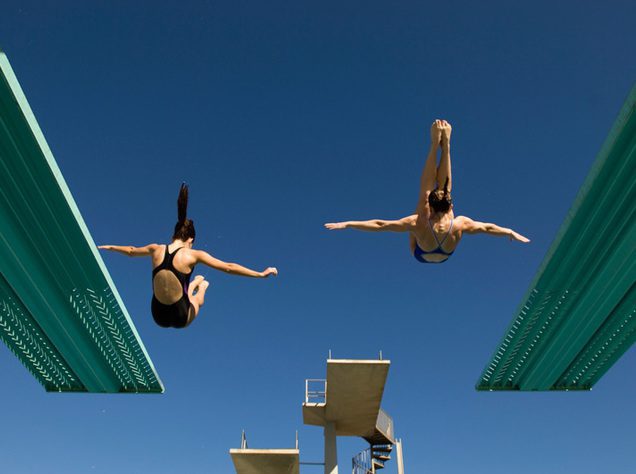In competitive diving, divers can compete in pairs during an event in what is known as synchronized diving. Synchronized diving events take place on either a 3-meter springboard or 10-meter platform. The pairs consist of either two males or two females. In this sport, two divers dive at the same time. Their movements, from the take off all the way through the entry, are mirror images of each other. Think of how much practice and talent it takes for two dancers to perform a routine together completely in synch. Now imagine doing all of that while free falling into a pool of water. Synchronized diving requires two divers to be completely in tune with one another. One slight movement too late or too early will stick out like a sore thumb to the judges.
There are not separate meets for synchronized diving, it’s simply just another event at the competition. When it comes to scoring the dive, there are many similarities between synchro and individual. The judges evaluate everything about the dive including the take off, the flight and the entry the same as within individual competition, but they also evaluate the synchronicity of the dive. Unlike individual, which has five or seven judges on the panel, synchro has a nine-judge panel. Two judges evaluate the execution of one diver, and two more evaluate the execution of the second diver. The remaining five judges evaluate the pair’s synchronization.
The highest and lowest scores of the pair’s execution are dropped, and the remaining two are added together. The highest and lowest scores of synchronization are also dropped, and the remaining three are added together. The sum of these five remaining scores totals the team’s raw score. Then, like individual, the raw score is multiplied by the degree of difficulty, which is derived from the amount of difficult combinations within the dive. That score is then multiplied by 3/5 or .6 to give the final score of the dive. The final scores for each dive in the set are totaled at the end of the competition, and the team with the highest overall score is declared the winner.
However, there are different rules regarding synchro within a competition. In men’s synchro, a team must perform six dives, two of which must have an assigned difficulty degree (DD) of 2.0. Women have the same rules, but only perform a total of five dives. The remaining dives in their set are known as optional, meaning that there is no limit to the degree of difficulty used. There are five groups of dives: forward, backward, inward, reverse and twist. In synchro, four out of the five groups must be performed in their set.
Synchronized diving is extremely challenging, and you must have a partner that you work well with in order to be successful. Most synchro teams also compete individually on other events. Because of this, many divers already have their personal style for executing a dive. In synchro, however, divers may have to alter their approaches in order to make their dive identical to their partners. This can be challenging. Creating a system of verbal or visual clues can be helpful. Synchronized diving takes a lot of practice to master, but when you do get it right, it’s truly incredible to watch!
CoachUp is the safest and easiest way to find a private sports coach. With our 100% money-back guarantee and vetted coaches, anyone can achieve their full athletic potential. Find your perfect private coach today and become the athlete you want to be!
How useful was this post?
Click on a star to rate it!
Average rating 0 / 5. Vote count: 0
No votes so far! Be the first to rate this post.



